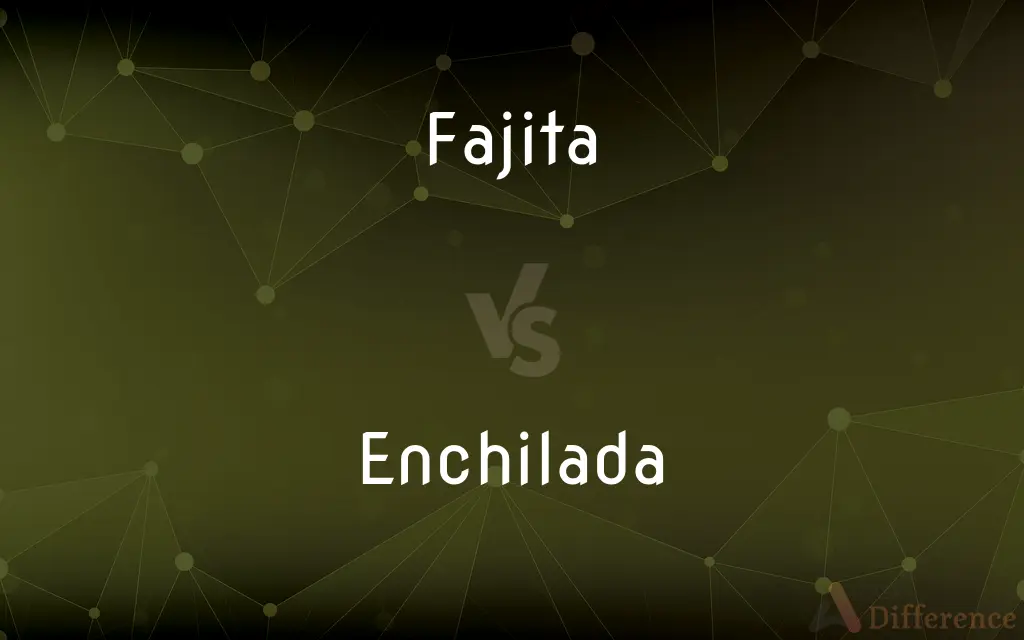Fajita vs. Enchilada — What's the Difference?
By Maham Liaqat & Fiza Rafique — Updated on March 11, 2024
Fajitas are a Tex-Mex dish featuring grilled meats served on a flour or corn tortilla, while enchiladas are traditional Mexican dishes of corn tortillas rolled around a filling and covered in chili sauce.

Difference Between Fajita and Enchilada
Table of Contents
ADVERTISEMENT
Key Differences
Fajitas originate from the Tex-Mex cuisine, a fusion of Mexican and American culinary traditions, primarily known for sizzling meats and vegetables served on tortillas. The key ingredients include marinated, grilled strips of beef, chicken, or other meats, often accompanied by sautéed peppers and onions. Enchiladas, deeply rooted in Mexican cuisine, consist of corn tortillas rolled around a filling, which can include meats, cheese, beans, or vegetables, and then smothered in a chili sauce, often garnished with cheese, sour cream, or other toppings.
The preparation of fajitas involves marinating and grilling the meat, which is then typically presented on a hot plate with tortillas and condiments on the side, allowing for a customizable dining experience. Enchiladas, however, are assembled by filling and rolling tortillas, covering them with sauce, and then baking them, resulting in a cohesive dish often served with sides like rice or beans.
The serving style of fajitas is interactive and communal, with diners often constructing their own tortillas with their preferred mix of meat, vegetables, and toppings like guacamole, salsa, and sour cream. Enchiladas are served as a complete dish, with the sauce and fillings chosen by the cook, offering less customization at the table but a rich blend of flavors in every bite.
Sauce plays a different role in each dish; fajitas may be served with various salsas and condiments on the side, while the sauce is a central component of enchiladas, crucial for their flavor and texture. The type of chili sauce used in enchiladas can vary by region and personal preference, ranging from mild to very spicy.
Despite their differences, both fajitas and enchiladas are beloved for their bold flavors, satisfying textures, and the warmth they bring to the table. They reflect the diversity and richness of Mexican and Tex-Mex cuisines, each offering a unique taste experience rooted in tradition and culinary innovation.
ADVERTISEMENT
Comparison Chart
Origin
Tex-Mex cuisine
Mexican cuisine
Base
Flour or corn tortillas
Corn tortillas
Preparation
Grilled meats and vegetables
Rolled tortillas filled and covered in chili sauce
Serving Style
Assembled at the table
Pre-assembled and baked
Sauce
Served on the side as condiments
Integral part of the dish, enchiladas are covered in it
Customization
High, with various toppings and fillings
Low, as dish is pre-assembled
Cooking Method
Grilling
Baking
Key Ingredients
Marinated meats, peppers, onions
Fillings (meat, cheese, beans), chili sauce
Compare with Definitions
Fajita
A communal, customizable meal.
Fajitas are perfect for family dinners, everyone can make their own.
Enchilada
Corn tortillas filled and covered in chili sauce.
She savored the spicy beef enchiladas, topped with melted cheese.
Fajita
Strips of marinated meat with vegetables.
The fajitas featured perfectly grilled steak strips and colorful peppers.
Enchilada
Can be filled with various ingredients.
Vegetarian enchiladas were filled with beans and cheese.
Fajita
Tex-Mex grilled dish served on tortillas.
We ordered chicken fajitas with a side of guacamole.
Enchilada
Known for their rich sauce.
The key to delicious enchiladas is the homemade chili sauce.
Fajita
Served with a variety of condiments.
The table was laden with salsas and sour cream for the fajitas.
Enchilada
A traditional Mexican baked dish.
Enchiladas are a staple in Mexican cuisine, with numerous regional variations.
Fajita
Originating from the Texas-Mexico border.
Fajitas blend Texan and Mexican culinary traditions.
Enchilada
Served with sides like rice and beans.
The enchiladas came with a side of refried beans and rice.
Fajita
A fajita (; Spanish: [faˈxita] (listen)) in Tex-Mex is any stripped grilled meat with stripped peppers and onions that is usually served on a flour or corn tortilla. The term originally referred to skirt steak, the cut of beef first used in the dish.
Enchilada
An enchilada (, Spanish: [entʃiˈlaða]) is a corn tortilla rolled around a filling and covered with a savory sauce. Originally from Mexican cuisine, enchiladas can be filled with various ingredients, including meats, cheese, beans, potatoes, vegetables, or combinations.
Fajita
A dish consisting of strips of marinated meat or vegetables that are grilled over an open fire and served in a tortilla, usually with spicy condiments.
Enchilada
A tortilla rolled and stuffed usually with a mixture containing meat or cheese and served with a sauce spiced with chili.
Fajita
A Tex-Mex dish of strips of spicy marinated meat and/or vegetables in a soft flour tortilla, often served with salad or a savoury filling.
Enchilada
A Mexican dish made by wrapping a filling in a tortilla, then baking in a sauce.
Enchilada
Tortilla with meat filling baked in chili-seasoned tomato sauce
Common Curiosities
Are fajitas considered authentic Mexican food?
Fajitas are more Tex-Mex than traditional Mexican, a blend of Mexican and American cuisines.
What are common fillings for enchiladas?
Enchiladas can be filled with meats, cheese, beans, or vegetables.
Is there a cheese-only version of enchiladas?
Yes, cheese enchiladas are a popular variation, filled and topped with cheese.
Can enchiladas be made without chili sauce?
Chili sauce is a defining feature of enchiladas, but variations might use different types of sauces.
How are enchiladas garnished?
Enchiladas are often garnished with cheese, sour cream, lettuce, and diced tomatoes.
What's the difference in tortilla preparation for fajitas and enchiladas?
For fajitas, tortillas are served fresh or lightly grilled; for enchiladas, they're often lightly fried before rolling.
Do fajitas always come with peppers and onions?
Peppers and onions are traditional for fajitas, but other vegetables can be used.
Can leftover meats be used for making fajitas?
Leftover meats can be repurposed for fajitas, making it a versatile dish.
Can flour tortillas be used for enchiladas?
Traditionally, corn tortillas are used for enchiladas, but some variations might use flour tortillas.
Are fajitas typically spicy?
Fajitas can range from mild to spicy, depending on the marinade and condiments used.
What are some common sides for fajitas?
Common sides include rice, beans, guacamole, and salsa.
How do you prevent enchiladas from becoming soggy?
Lightly frying the tortillas before rolling and not oversaturating with sauce can help prevent sogginess.
Are enchiladas served with sauce inside and out?
Enchiladas are filled, rolled, and then covered in sauce, fully incorporating the sauce into the dish.
Can fajitas be served cold?
Fajitas are best served hot, straight from the grill, for the best flavor and experience.
Can fajitas be made vegetarian?
Yes, fajitas can easily be made vegetarian by substituting meats with vegetables or plant-based proteins.
Share Your Discovery

Previous Comparison
Cheat vs. Betray
Next Comparison
Modelized vs. ModelizeAuthor Spotlight
Written by
Maham LiaqatCo-written by
Fiza RafiqueFiza Rafique is a skilled content writer at AskDifference.com, where she meticulously refines and enhances written pieces. Drawing from her vast editorial expertise, Fiza ensures clarity, accuracy, and precision in every article. Passionate about language, she continually seeks to elevate the quality of content for readers worldwide.














































